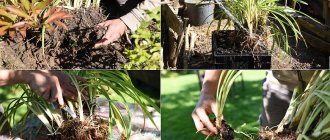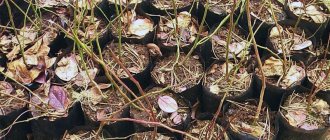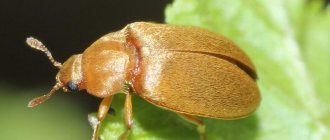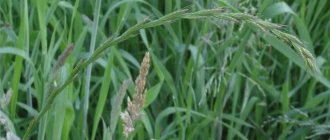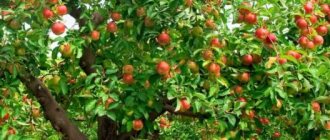It can be argued that a large number of gardeners are happy to grow such a wonderful berry as blackberries on their plots. Summer residents recommend growing not just one bush, but several, perhaps even up to a dozen. Blackberries are the most delicious and have an excellent composition of nutrients. There is also a belief that you can never have too many tasty berries. Sometimes beginners in this business are faced with the question of how to propagate blackberries correctly?
There are many ways, but some take a lot of time, while others do not require much effort and time. Which one to choose is only your decision. In our article we will help you figure out how to choose a variety for propagation, what method to propagate, how to do it correctly for the prosperity of the crop in your summer cottage, and what time of year to choose.
Blackberry propagation methods
There are many methods for growing berry bushes. Depending on the type of plant, one or another method is used. For example, bush remontant blackberries (Ruben and Gigant varieties) reproduce well by dividing the bush or by root buds. And such a high-yielding variety as Texas is absolutely incapable of producing root shoots, so it is propagated by dividing the bush or by layering. For creeping species (Natchez varieties, thornless Polar), the method of layering is also suitable, as, for example, with grapes.
Self-grown blackberry seedlings
Erect bushes (thornless varieties Thornfree, Lawton, Black Satin), which produce many basal shoots, are best rooted using side shoots or the top.
Blackberries can be propagated at any time of the year except winter. Spring is ideal for growing seedlings from seeds and dividing the root while replanting the mother bush. In Siberian conditions, spring is the best time for blackberry propagation. Cuttings develop very quickly during this period of the year.
Propagation by root cuttings
Summer is a wonderful time for propagation by layering, obtained by burying shoots in the ground. At the same time, you can plant a blackberry bush, dividing it into several daughter plants.
Important! Increased summer temperatures can interfere with the survival of a young bush. In hot weather, the soil with new seedlings must be mulched to avoid loss of moisture and overheating of the soil.
Preparing seedlings for planting in a summer cottage
Autumn is also suitable for rooting a blackberry vine by securing it in a groove with a fork or a hook and covering it with soil on top. During the cold winter period, buds from a buried branch will produce roots. In the spring, all that remains is to separate the rooted vine and replant it.
The most common methods of reproduction:
- By layering;
- Offspring;
- Root cuttings;
- Stem cuttings;
- Green cuttings;
- Dormant kidney.
- Dividing the bush
Below, each method is discussed in more detail.
Popular ways to propagate garden blackberries
The method for propagation completely depends on the varietal characteristics of the blackberry:
- It is recommended to propagate upright varieties of plants using root suckers and cuttings, and dividing the bushes. It is theoretically possible to use apical or horizontal layering, but in practice it is practically impossible;
- Creeping varieties - use the apical shoot method (apical layering): horizontal layering, root shoot and cutting, young green cutting.
Important point! Thornless varieties have some originality that distinguishes them from other varieties of blackberries. That is why propagation by suckers and root cuttings is not recommended; this method is perfect for prickly blackberry varieties.
Let's highlight the main ways to propagate blackberries. There are 5 most basic ones, but they are divided into two groups:
- effective;
- less effective.
In the first option, we can note: layering, root suckers and cuttings, dividing bushes. For the second case, emphasize: seed method, use of stem cuttings.
Almost any gardener initially determines not only the propagation time, but also selects the most appropriate method for himself. That is, it tries to find optimal conditions to facilitate the process. Obtain new planting material depending on the selected variety. Further in our article we will try to consider in more detail all the listed methods of how to propagate blackberries, as well as the detailed features of each method separately.
Seed method
In terms of simplicity, it is the most used for propagating any variety of blackberry bushes. But this is only from the point of view of simplicity. In fact, experience has established that the effectiveness of this method has a reduced percentage in the results. This applies not only to blackberries, but also to many other fruit and berry crops. One might say, not even a practical way. It is recommended to replace it with the vegetative propagation method. We will talk about these in more detail in the article.
Important! During seed propagation, the varietal characteristics of the mother bushes are lost, that is, all the characteristics of the variety that you wanted to get along with the young plant simply disappear.
Using seeds of one variety, you can get completely unexpected results.
Using the method of planting seedlings (seed method), we use standard rules. Remember: seed material of blackberry varieties is initially subject to stratification for at least 2 months. And only then, just before sowing, apply scarification. Next, after all these processes, we simply sow it into any suitable container.
How to propagate blackberries by apical layering
Blackberry propagation scheme by apical layering
Propagation by apical layering means obtaining new material by simply burying the tips of the shoots into the soil, given that blackberries have a natural ability to take root well.
Important! Plant propagation by this method is almost ideal in relation to creeping varieties.
For varieties with erect, semi-creeping shoot development, this method is less optimal. The completely upright development of bush shoots is less willing to accept such reproduction. It is very difficult to bend the top of the plant and bend it to the ground in order to root (for example, Darrow, Agawam).
It is most optimal to carry out the propagation procedure in this way in early September. The climate of the southern regions is very different from the middle zone, so blackberries can be grown there at the very beginning of the summer months. Then you will receive a young plant for this season.
If we consider the method step by step, then some important points are determined:
- We pinch off the growth point of the bush chosen for propagation. Fact! If you ignore mandatory recommendations, your chosen shoot, after a certain period of time, will crawl out of the soil to the surface and begin active independent development. The roots in the place where they were buried simply do not have time to form and take root, so you do not get a new seedling.
- We tear off all the leaves;
- We bend the shoot that has been pinched and dig it into the soil to a depth of 10 centimeters. You can also use a separate pot for this purpose, that is, deepen the top into a container with soil. For many gardeners, this method is considered more convenient.
Attention! The shoot that you have deepened is prohibited from being separated from the mother plant. The young shoot still receives the necessary nutrition from the mother plant. Without an adult plant, a young cutting simply has no chance of survival in the absence of a root system, which begins development after the shoot takes root.
This is a vicious circle and if you break one chain of actions, you will not get results. After rooting, the young shoot is able to form a growth point underground, which will allow it to begin independent development and activate full growth. All results depend only on the characteristics of the blackberry variety you choose and the rooting period. Perhaps already this season, in early September, an independent new shoot will form. But in most cases, this is still observed only next spring.
How to propagate blackberries by horizontal layering
A closer look at the two methods described above and the one currently under consideration reveals practical similarities. When using the horizontal propagation method, you may encounter some difficulties: in order to bend the shoot to the soil surface, especially to deepen it a little further, you will have to try very hard not to break the necessary shoots, because the branches of the plant are quite powerful, and an upright plant does not have much elasticity.
The recommended and most optimal time period for applying this method is the second half of August. You can capture the beginning of the autumn season a little. The southern regions of the regions differ in climatic conditions, so we calmly begin to propagate by layering from the middle of the summer season.
This method can only be used if there are several blackberry bushes on your site, since for propagation we take shoots that can perform fruiting functions only in the next season.
Step-by-step consideration of propagation by horizontal layering:
- We make a small depression in the soil - a groove, no deeper than 20 centimeters. It is necessary to choose an elongated shoot, which must be one year old. We bend the selected material into the center of this groove; it is necessary to secure it with any available means: a bracket, a hook, a brick located on top of the soil on an already dug layer. Important! The top of the plant is completely cut off only after all excavation work has been completed.
- Next, sprinkle 15-17 centimeters of soil. About the size of a shovel. Continuing work, add a layer of mulch to the soil surface. This will help prevent the soil from drying out in the future. Water immediately.
Of course, the appearance of a new layer may occur in the current season. It all depends on climatic conditions, but the best option would be the appearance of a young seedling in early spring next season.
Then the seedling will definitely be well rooted, with its own developed root system. Calmly dig it up and separate it from the mother bush, if you didn’t do this before wintering. We are already determining a permanent place of cultivation.
How to propagate blackberries using root suckers
Blackberries, like a plant similar in all qualities, raspberries, take root very well and are very difficult to get rid of, so excellent propagation by root shoots occurs.
What is the peculiarity of this method of reproduction? When you start digging up all the bushes in a row to free the area from a given crop, no matter what the reasons, small shoots of the root system always remain in the soil. Even the small remaining part of the root can give rise to a new shoot.
What is needed for such propagation of blackberry bushes, especially since this is the most classic method? Dig out and cut the root into small pieces in sufficient quantity. Each segment is approximately 10 centimeters in length and up to 4 mm in diameter. Root shoots (cuttings) can not only be prepared, but also stored until a certain time when needed.
How to do it. The root material is taken from the depths of the root middle, at least 60 cm deep, this way you will not harm the main mother bush.
The roots can be stored in a regular cellar, where a container with wet sand is placed. You can replace such a place with an analogue one and store it in convenient conditions.
In the spring, we bury the roots (sprouts) in the soil, and only in a horizontal position, the vertical method is not even considered. The depth of the holes for the offspring does not exceed 5 centimeters.
We water and then regularly monitor soil moisture throughout the season.
Need to know! There is one important fact that not all varieties of blackberries, when propagated in this way, retain their varietal characteristics. For example, if you try to propagate thornless varieties, you may end up with young shoots with thorns. So this method is popular among gardeners who grow mainly thorny varieties of blackberry bushes.
Propagation by root cuttings
Root suckers can be used a little differently, with shorter root cuttings. It is advisable to do this if you have a greenhouse or greenhouse. To prepare such material, we take a piece of root, only up to 3 cm in length.
It is important to know! The use of root cuttings must be carried out in full compliance with polarity at the time of planting in the soil. The location of the segment, the top and bottom, is only in the same direction as when cutting from the mother root. That is, the lower parts are down, the upper parts are up.
Advice for newbies! In order not to simply confuse the directions of small root cuttings (polarity), you can do the following: when cutting the main root into smaller parts, cut the top of the shoot perpendicular to the main axial part of the root, the lower part is cut at an angle, more pointed.
Next, we place the offspring in the prepared holes, but in a vertical position, up to 6 cm in depth. Therefore, from the top of the segment to the ground surface is at least 3 centimeters. New shoots begin to appear within a few weeks after planting.
The principle of propagating blackberries by root cuttings or scion is very similar, there is no particular difference. Root cuttings are used when dealing with more creeping varieties, as they are not capable of producing a large number of root shoots. There are, of course, cases when an upright plant does not produce such root shoots, then the method with root cuttings is applicable.
We may repeat ourselves, but we will clarify the information. Thornless varieties cannot be propagated using this method. Because the result of the work differs from the desired result. 80% of blackberry bushes can grow prickly.
Let's summarize this point of the conversation: propagation by root cuttings occurs in autumn or early spring. Very carefully dig out the entire root system of the mother plant. The roots must be cut at a distance of at least 60 cm from the base of the root. For such propagation, we use only those bushes that have reached the age of three. The average thickness of such a formed root is up to 1.5 centimeters.
The length of young offspring is only 5-10 centimeters. The prepared material can be used at the same time, or can be left for storage at home. For the winter, the collected root material is transferred to the basement and must be stored in a container with damp sand. In early spring, cuttings must be planted in open ground.
As experienced gardeners advise, the cuttings can be germinated a little before planting. To do this, simply place the root sections in a small container with sawdust, slightly moistened. In a couple of weeks they are able to produce small shoots.
During planting, the cuttings must be placed in a furrow; it is advisable to create rows for planting with root cuttings, this way there is a better chance of getting enough material. The depth of the groove is no more than 12 centimeters. The distance between the furrows is up to 20 cm, and the row spacing should be up to 80 cm wide, in case the young shoots can take root very quickly and begin active development.
Sprinkle the laid cuttings with sufficiently loose soil and carry out regular watering until rooting. During the summer season, it is advisable, even recommended, to carry out up to 7-10 loosening and weeding of weeds in the furrows.
If you follow all the step-by-step instructions for the fall, you will receive excellent planting material for your garden. New seedlings are sufficiently formed and have at least 2 high-quality shoots and a developed root system.
How to propagate blackberries from cuttings. Using green or woody stems
Lignified stem cuttings, or green ones, can be used to propagate blackberry plantings. Since the cuttings are green, therefore, harvesting is carried out in the summer, June-July.
This method can be easily combined with classical pruning during the summer growing season. When bushes are cut for shaping and to comply with the norm in additional shoots.
Fact! The method is applicable for creeping varieties. A similar method is used for the following varieties: Black Satin, Thornfree, Thornless Logan. There are varieties of blackberry hybrids that are unable to reproduce using this method, for example Dirksen Thornless. Smutstem is completely incapable of rooting.
The sequence of blackberry propagation in a similar way. In mid-summer, green cuttings are cut from the shoot in small pieces. There must be at least 2 development buds on them.
Only a third of the shoot tip can take root, and it is desirable and recommended to cut off the tips where the last two buds are located. As a result, the cutting has no more than 2 leaves, the bottom of which is removed, leaving only the cutting of the leaf. The top sheet must be shortened by half.
After this, plant the finished cuttings in a small container; you can use ordinary plastic cups. The container is filled with the required soil composition: part peat + part loose composition (perlite, sand).
Take note! For high-quality rooting, each cutting can be treated before planting by dipping it in a growth and root formation stimulator. You can use Heteroauxin or Kornevin.
Afterwards, all containers with cuttings are moved to a greenhouse or greenhouse. The humidity there is quite high, which promotes comfortable germination of the cuttings. In greenhouses, when water evaporates, a kind of fog is always formed, and it is this that contributes to positive results.
You can also create a mini-greenhouse if there is no greenhouse. We simply cover the containers with cuttings with glass or film. After a month, you can observe the active growth of seedlings and the formation of roots. After a month and a half, we transplant the young bushes to a permanent plot for growing blackberries.
Note! The absence of high humidity and the like of fog will lead to a lower percentage of the expected result. Most cuttings will not take root. Statistics show only 10% of germinated planting material. In general, the method is considered ineffective if the necessary conditions are not created.
Application for propagation of lignified cuttings. A similar method is used in the case when you did not prepare green cuttings during the summer season. In the fall, it is possible to cut cuttings that are already more lignified.
Important point! Not every variety of blackberry is subject to this method; a lot of the harvested material will simply die.
What is needed for high-quality propagation from lignified cuttings:
- First, in the autumn season we select an annual bush that has developed substantial shoots; the cuttings are cut at least 20 centimeters in length (maximum 30 cm).
- Secondly, we dig it into the garden to a depth of 20 centimeters. So we leave it for the winter. In the spring we dig it up and renew the cutting area, only on both sides. As a result, the length of each stalk is at least 20 cm.
We place the material in rows at a distance of 10 cm from each other, and re-sprinkle with soil. Weeding and watering should be carried out regularly. We're just waiting for the shoots to emerge. You can create something like a greenhouse, arrange arcs and cover it with polyethylene. After germination of the bushes, which have up to 3 independent leaves, we carefully remove them from the ground and plant the cuttings in a permanent place for growing blackberries.
There is a method of propagation, although less popular, - using a dormant bud by placing it in water (similar to propagation by lignified cuttings). How it's done. Already at the end of February and beginning of March, we place the cuttings prepared in the fall in jars with water; the container must be placed on the windowsills.
The top of the cutting should be directed downwards, that is, it should be in the water. It is on the upper part that the apical buds begin to appear. Fill the container with water so that it covers only the lowest bud. Water tends to evaporate, so it needs to be constantly refilled.
After 1-3 roots appear, you can transplant the cuttings into a separate container (or a pot) filled with loose soil. Provided the outside temperature is consistently warm, the seedling can be safely planted in a permanent location. It is necessary to take into account not only the temperature outside, but also the heating of the soil. You should not place the seedling in poorly warmed soil.
How to propagate blackberries by dividing the bush
Blackberry propagation scheme by dividing the bush
This method is used when it is not possible to use the methods described above. In cases where:
- the bush is not able to form additional young shoots;
- it is impossible to bend the top of the plant to the soil (erect varieties).
Regarding the timing for reproduction using this method. Dividing the bushes is possible at the very early stage of spring: when the last snow has melted, you can begin the process. If the procedure is carried out in the fall, then four weeks before the first frost appears. During the period before the cold weather, a young shoot can practically take root.
The use of this method of propagation occurs during normal autumn work with blackberry bushes, when they are prepared for the winter, classical stratification of the bushes is carried out, and the seedlings of the divided bush have time to develop excellent immunity.
Before doing this, you need to dig up the bush itself. Next, we divide the bush into almost equal parts; on each division there should be at least 2-3 independent shoots with well-developed roots. And on the roots there is at least 1 underground bud. Bushes older than 3 years are not used for such propagation.
We follow standard actions. Divided seedlings must be placed in pre-prepared holes. When choosing a bush for division, take into account age, quality, the presence of individual shoots, and whether the root system of each separated part is developed. If you choose the right bush that is powerful enough, you can get at least 6 new bushes.
By layering
Climbing blackberries are ideal for this method of breeding. At the same time, there should be a lot of bushes on the plot, since healthy fruit-bearing branches are used here to form planting material, which can reduce the future harvest.
In order to propagate garden blackberries by horizontal layering, you need to do the following manipulations:
- In mid-August, when it is no longer too hot, dig a ditch up to 20 cm deep and place an annual shoot in it so that only its tip remains above the ground. To secure the blackberry branch in the trench, use a hook at the base and end, or press down on top with a brick.
- It is recommended to trim the top of the shoot by about 10 cm. This will stop growth and redirect all the forces of the future seedling to rooting and developing new shoots.
- Fill the groove with the fixed vine with earth.
- Mulch the cuttings thoroughly and water them generously.
Within one or two months, by the beginning of October, new shoots with their own root system will already appear on the buried branch, which must be immediately dug up, carefully separated from the mother bush, and planted in a prepared place.
If you dig up the cuttings in this way at the end of September, then you can replant the newly formed bushes in early spring, when the snow melts.
In addition to horizontal, apical layering can also be used for this method of propagation. The tip is cut in the same way, but the top is dug in, and then all the above steps are repeated. Creeping blackberry varieties can very easily reproduce from the tips of their shoots. In addition, with this method the harvest will not be damaged.
Preparing cuttings for propagation
Important! For faster rooting, experienced gardeners advise cutting the bark in a place that will be in the ground. This will make the roots grow easier and the young plant will form faster.
With proper care, the cuttings rooted in this way will begin to produce crops already in the second year of independent life.
Planting cuttings in the ground and caring for them
Before planting a crop, you need to choose an area protected from cold winds, which is well lit by the sun, without stagnant water. Blackberry bushes take root well in beds where legumes and cereals were previously grown.
Important! If, when planting, you do not completely fill the holes, but leave small holes, then less water will be required during irrigation. In winter, snow will accumulate in them, thus, useful melt water will flow to the root system of the plant.
In the spring, the cuttings are planted in the ground before the buds open, and in the fall - before the first frost. They are placed in furrows to a depth of 10 cm in a horizontal position. After this, they are covered with soil and watered abundantly. The main conditions for caring for the site are periodic fertilization, weed removal and mulching.
Offspring
A young shoot growing from a rhizome is called a scion. Erect blackberries reproduce in this way. During the summer season, about twenty young offspring grow around the bush. Basically, such shoots are removed so as not to interfere with the development of the mother plant.
For breeding, offspring are selected carefully:
- The mother bush should be highly productive and healthy, and the shoot from it should be 10 to 12 cm in size.
- In May or early June, the selected offspring is carefully separated from the adult bush using a bayonet shovel.
- Organic fertilizers are added to the finished hole, then the shoot is placed there, mulched and watered well.
If in the spring the offspring are still weak and underdeveloped, they are left until the fall near the mother bush, providing increased care, and in September the stronger plants are planted.
The most effective method
Features of cuttings of blackberry species
The method of propagation will depend on what type of blackberry you choose. And although cuttings are considered a fairly effective method, there are still certain features.
Thornless
Under no circumstances should the root cutting method be used for thornless varieties. Such propagation will result in bushes with thorns. With green and woody cuttings, most of the shoots may die, so this is not a very effective propagation method for thornless blackberries.
Video: propagation of thornless blackberries by cuttings
Remontantnaya
The main difference between remontant blackberries and other varieties is the ability to bear fruit twice a year. Rooting of cuttings occurs in the summer so that the finished seedlings can be planted on the site in late August or early September. Thus, in the spring, young bushes will be able to bear fruit.
Stambova
Standard blackberries are best propagated by cuttings from woody shoots. This is a fairly old method, but very effective. In order for standard varieties to take root well, they need to be provided with constant feeding.
Important! Before planting cuttings, soak their roots in water for at least 12 hours. Thus, the seedlings will take root better and adapt faster in open ground.
Ordinary
Common blackberries are successfully propagated by any method of cuttings. But the most effective will be root cuttings. This way you will get a lot of strong seedlings. Be sure to regularly water and feed the cuttings. In just a month, the planting material will be ready for planting.
Root cuttings
In winter, when trips to the country are reduced, and the desire to grow something does not disappear, you can continue to grow blackberries at home in a city apartment by cutting the root of the plant. But there is one condition: planting material must be prepared in advance. In this case, it is better to cut root cuttings 6-9 cm in length and 0.3 - 1.5 mm thick, using a replanted bush. For these purposes, you can carefully dig up the soil under the bush, and, after cutting the cuttings, bury it back.
If the material for planting was prepared in the spring, then the resulting parts of the root should be distributed on the surface of the prepared container and sprinkled with soil to a thickness of about 3 cm. When the emerging seedlings have grown sufficiently and the spring frosts have passed, the young plants can be planted in open ground.
How to choose the right root cuttings
If the blackberry root was harvested in the fall, then the planting material should be stored in the cellar or in the refrigerator in a plastic bag, maintaining a temperature of + 2 to + 5 ° C at the storage location. Once every 7 days, the package should be taken out to ventilate and check the condition. Then, at the end of February, plant the root material in containers as described above and place them on the windowsill.
Bushes grown in containers can be planted in open ground once the weather becomes warmer. This home propagation method is good because the germination rate of root cuttings will be about 70% if everything is done correctly.
Rooting
Specifics of blackberry propagation at different times of the year
Growing blackberries in natural conditions at home is not so difficult. Planting at certain times of the year has its own specifics. Plants are mainly planted in spring and autumn. In summer, bushes are planted in extreme cases, when there is no other opportunity to plant blackberry bushes. In autumn, it is recommended to plant the plant in the southern and central regions.
High humidity promotes spectacular root growth in winter. With the onset of spring, seedlings actively begin to grow.
When cuttings are planted in the spring, they do not have time to take root before the onset of warm weather. And when it gets warm, the cuttings immediately begin to increase their leaf mass, which does not have a very good effect on the yield and health of the plants. In autumn, cuttings are planted one month before the onset of cold weather. And in the spring, you need to plant cuttings until the air temperature rises to +15 degrees.
Stem cuttings
Propagating blackberries by stem cuttings is a very popular method. This method can be used to grow absolutely any variety of blackberry plant. Experienced gardeners recommend doing the following:
- With the onset of autumn, take cuttings from annual stems. To do this, using secateurs as garden tools, shoots with lignified bark should be prepared in such a way that each cutting is about 40 cm long.
Important! The stems of blackberries (for example, the very prickly variety Karaka Black) of almost all varieties are covered with thin needles. To avoid getting hurt by a thorn or splintering your hands, you should wear gloves when working.
- Then bury the resulting cuttings 20 cm into the ground until spring.
- In the spring, dig up the planting material again and refresh the cuts on both sides. Place each stem cutting at a distance of 10 cm from one another and cover it again with soil.
- For better germination, you should cover the future blackberry with a film on the arches. The greenhouse must be opened and ventilated periodically. It is better to water the planting with water that has settled in a barrel, not forgetting to weed out any weeds that appear.
- As soon as the small bushes with three leaves sprout, it will be necessary to remove the cuttings from the ground with extreme care. Each of them will contain 2 or 3 sprouts with roots, which should be divided and planted in separate containers for growing.
- As soon as the seedlings grow new leaves and their stems noticeably lengthen, you can begin planting them for permanent residence.
You can try propagating blackberries directly in the spring using cuttings from the stem. But you will need to have time to cut and root before the buds open.
The method of propagation by stem cuttings has many advantages, including ease of use, versatility of the method, and most importantly, a large number of resulting seedlings.
Advantages of blackberries
Blackberries contain a chic set of vitamins that are beneficial for the human body. Once you try blackberries, you will never forget this pleasant and unusual taste. It is not at all troublesome to grow high-yielding blackberry bushes in your dacha.
Every gardener is proud that this magnificent berry grows on his plot. I plant blackberries near fences, thereby creating magnificent hedges that can complement the design of a summer cottage.
Many Russian residents perceive blackberries as a novelty. And this is understandable, because raspberries, currants or gooseberries are much more popular. And if you take this into account, you can earn yourself some capital by selling seedlings.
The more you want to harvest, the more seedlings you should plant. The risks of bushes dying from weather disasters, disease or harmful insects are reduced to almost zero. And if several plants do not bear fruit this season, others will fulfill its function.
Green cuttings
You can propagate blackberries in the summer using green cuttings taken from the top of the plant.
To do this you need the following:
- Cut off the tops of different shoots in July. The length of the green cutting should be approximately 20 cm, and the cutting angle should be 45°.
- From the bottom of the resulting shoots, a small stalk is cut off, on which there should be two leaves. The top is not taken for breeding.
- The bottom leaf must be cut off, not forgetting to leave a small stump, and the top one must be shortened by half. The cuttings should have a healthy greenish tint.
- The resulting cuttings should be kept in a root growth stimulator, such as Kornevin, and then placed in separate containers, which are filled with equal parts of garden soil, peat and perlite. For pots with cuttings, it is necessary to make an unventilated greenhouse, which must maintain a humidity of 96% at a temperature of 30°C.
- When new leaves appear on the seedlings, you should begin to ventilate.
- After a week, you can be transplanted to a permanent place of residence.
Selection of green cuttings for propagating berry bushes
In summer, propagation of blackberries by cuttings from the top is unproductive. The disadvantage of this method is the low survival rate - only 10% of the initial planting. In addition, the method requires high labor costs.
The main mistakes when taking blackberry cuttings
To avoid mistakes when cutting blackberries, you should adhere to the basic rules for this procedure:
- First of all, you need to observe the planting deadlines and start it under suitable weather conditions. This is necessary so that the growing season of blackberries passes without problems.
- Cuttings require constant care and control.
- It is best to root the cuttings immediately in open ground, so that later when planting you do not damage the delicate roots.
Find out what blackberries on your site are incompatible with.
Propagating blackberries is not a difficult and quite interesting task. By adhering to certain rules, you will definitely be able to grow strong blackberry bushes on your plot, which will delight you with a rich harvest year after year.
Seeds
The seed method of propagating blackberries will require a lot of patience from the gardener. The first fruiting here is possible only after 4 years, and a full harvest can be harvested only after 5 years.
Important! The germination rate of blackberry seeds from stores is only 10%, while planting material from breeders or personally collected has a germination rate of up to 80%.
Seed method
To collect blackberry seeds you will need overripe berries that have not been exposed to disease. The pulp from the fruit is washed several times with water, with large viable seeds settling at the bottom of the dish, while dummies and fibers remain floating on top.
The planting material, free of husks and fibers, is placed on a cloth or paper towel and slightly dried in a shady place, and then prepared for planting. The seeds are not sown immediately. They are kept in the refrigerator at a temperature of + 4 degrees for about three months in a plastic container, covered with sand, which is moistened from time to time. You can store seeds this way for no more than a year.
The best soil temperature for germination is from 25 to 28°C, so first seedlings are grown indoors, which are subsequently transferred to open ground. At the beginning of March, you can sow seeds for seedlings and grow them under a phytolamp.
However, there is also an autumn method of sowing in open ground. When the last leaves fall from the trees, sowing is done. The seeds overwinter in their natural environment and germinate in the spring. This method produces hardened and more viable plants and eliminates the need to grow seedlings.
Why is it worth propagating garden blackberries?
Growing blackberries does not require special knowledge, as many summer residents may think. Growing blackberry bushes is no more difficult than growing raspberries or fruit trees. Blackberry bushes can still rarely be found on domestic plots, although blackberries are unpretentious plants and are very easy to care for. The advantage of garden blackberries is the large amount of vitamins and microelements in ripe fruits. The berries are juicy and sweet, and they also make delicious jam.
Dormant kidney
For this method, cuttings no more than 15 cm in length with three dormant buds are harvested from one-year-old shoots in the fall. Such preparations are stored in the cellar or refrigerator.
Germination of dormant buds in the stem
What happens next is:
- In March, the cuttings should be removed, turning the top bud down, and placed in a transparent container.
- Pour water so that it covers only one bud without awakening the others.
- Water should be added as it evaporates and the shoots should be kept on the windowsill.
- The awakened bud will sprout as a shoot with roots. It should be separated and planted in a container with loose airy substrate.
- Then the next bud is placed in the water, and everything is repeated again.
This method is most suitable for climbing blackberries; cuttings of upright varieties do not root well this way.
Rooting methods
Blackberry cuttings can be rooted in water and soil. Each method is special in its own way and gives good results. Spring is considered the ideal time for this procedure.
Earth
Using this method, you will receive ready-made seedlings within a month. To do this, place the cuttings in wet soil, add fertilizer and build a greenhouse over them. The shoots will take root very quickly. You can grow sprouts directly on the windowsill.
Water
When using this method, the cutting is lowered, bud side down, into water. Over time, it will begin to wake up and a new shoot with roots will sprout. When this happens, carefully separate the sprout and transplant it into a pot of soil.
Dividing the bush
This method is used in cases where the cultivated variety does not produce either horizontal shoots or young shoots in the form of offspring.
The mother bush is divided in spring or autumn, digging it up and dividing it into parts. During the work, you should try to cause minimal damage to the root system of the plant for better survival in the future.
The easiest way to propagate is by dividing the bush.
To smooth out traumatic effects, the rupture sites can be sprinkled with wood ash. With this method, up to five new plants are obtained at a time, which depends on the size of the original bush.
Depending on the goals and capabilities of the gardener, you can choose any method of propagating garden blackberries. For beginners, the best method is propagation by apical shoots. Root cuttings are ideal for owners of small apartments. If you need a large number of seedlings for the landscape, then stem cuttings are the best solution for realizing the design idea.
How to propagate blackberries: choosing the time
In general, there are no specific standards for propagating blackberries, but there are recommendations from experienced gardeners. Which propagation method should you prefer and at what time of year is it most profitable to propagate blackberries? It could be spring, autumn or summer. The difference is that each period has its own ways to propagate the bush.
The ideal time for this process is spring. In this case, already rooted cuttings (root and stem), as well as young seedlings, are used. The planting is carried out in a permanent place, so the process is approached with full responsibility and careful adherence to all rules and recommendations. You can use plantings and root cuttings and suckers, propagation when dividing bushes.
During the summer period, blackberries can be propagated using the tips of the shoots, replacing them with the tips of layering. Also a method of horizontal layering. To be more precise, at this stage of the layering you can dig it into the soil, cut and root the green cutting.
Dividing a bush during the summer, that is, the active development of blackberries, entails a number of dangerous consequences: poor survival of the division occurs due to hot weather and prolonged elevated temperatures.
Of course, division is best done in spring or autumn. But, if you still decide, be sure to mulch the tree trunk area and follow the watering regime to preserve moisture in the soil. Young, divided shoots need moisture very much.
In the first days of autumn, they begin to harvest root shoots, as well as cuttings for further planting in the spring. Woody stem cuttings can be cut. Just like in the summer season, the tips of the shoot (apical layering) can be buried, horizontal layering is used.
And in the spring of the next season, you simply separate the young seedling from the mother plant and transplant it to a new, permanent growing location. In the fall, you can propagate the bushes by division, and also root a young green cutting.
Reproduction
There are approximately 40 species of cultivated blackberries. The most acceptable propagation option directly depends on the variety. This is why, in order to figure out how to propagate garden blackberries, you need to inspect the bush.
If the blackberry bush tends upward, then the best option for propagation would be with the help of root suckers. But if the blackberry bush needs a trellis, then the layering method will be an excellent option for propagation.
Caring for blackberries in the fall, preparing for winter
In the fall, you should clear the blackberries of dry shoots and dig up the soil between the rows. Before frost, you should water your blackberries well.
The most important thing in preparing for winter is to cover the plants. Mature blackberry plants tolerate frost with difficulty. Although many varieties of blackberries are frost-resistant, they are covered for the winter. To do this, blackberry bushes are tied with twine and tilted to the ground.
To avoid breaking the branches, the plant is thrown over the knee. Then the blackberries are covered with one or two layers of agrofibre. Secure the covering material with bricks or other heavy objects. They also make a flooring of pine branches on top.
Preparing blackberry cuttings
Green cuttings are taken from the bush in July. It is difficult to propagate with their help, since roots are formed in only every tenth cutting.
Propagation of gooseberries by cuttings in spring
Root formation requires high air humidity without drafts and constant air temperature. It is difficult to provide such conditions in the garden; a special greenhouse and equipment are required.
Maintaining the required air temperature at home is possible, but ensuring high air humidity in a city apartment with central heating is an almost impossible task.
It is better to propagate by lignified cuttings, which are prepared in the fall. On one-year-old mature shoots, smooth areas about 40 cm long are selected.
As an option, you can propagate blackberries in the spring using this method, without waiting for autumn.
The cuts are made with a clean, sharp pruner perpendicular to the stem. Cutting off the thorns is mandatory. Prepared cuttings are stored in a trench in the garden. To do this, you need to dig a hole or trench in the ground about 30 cm deep and place planting material there.
Additional Information. If necessary, you can store the cuttings at home in the refrigerator. To do this, they are placed in a plastic bag and placed in the lower compartment. Periodically, you need to remove the package and ventilate the contents.
Propagation by cuttings
Propagating blackberries by cuttings can hardly be called easy, but it deserves attention, and many gardeners pay great attention to it. For this type of propagation, only the green parts of the twig are used.
How to get a high yield of watermelons: learn the secrets of seed preparation
Raspberry varieties - description of the best types, cultivation characteristics and their properties. Care tips (120 photos and videos)
What is the difference between cherries and sweet cherries: the main differences and beneficial properties of cherries and sweet cherries. 150 photos and videos of growing cherries
The uniqueness of the method lies in the fact that each bud produces a bush. Almost all varieties can be propagated by cuttings. But this method is not suitable for propagating thornless blackberries. It will simply grow into a thorny blackberry.
Rules for planting blackberries in autumn
In autumn, blackberries can be planted in southern regions with warm winters. Young seedlings may not survive a harsh frosty winter. When planting blackberries in the fall, humus is added to the hole.
If in winter the snow cover is about 60-70 cm, then there is no need to cover the young seedlings. Snow cover of this height is enough to cover the plant. If there is no snow, it is better to cover the seedlings with agrofibre or other covering material. It is necessary to make a shelter during the last cold snap, before the onset of frost, so that the plant does not produce horizontal layering.
Important: You need to complete the autumn planting of blackberries before mid-October, if the weather is good. Autumn planting of blackberries begins in September.
If fall-planted blackberries overwinter well, you may be able to get your first harvest sooner than spring-planted blackberries.
Planting blackberries in a permanent place
Propagation of black currant by cuttings in spring
When the plants get stronger and grow, the gardener who raised them begins to form the future green hedge.
To do this, you need several posts and a roll of wire, twine or thick fishing line. Metal mesh fences are also decorated with blackberries.
Planting blackberries along the fence has several goals:
- 1) Create an impenetrable wall;
- 2) Decorate the unaesthetic metal mesh;
- 3) Save space for planting other plants.
In all cases, grown seedlings are planted in rows along the fence. The interval between plants for a hedge should be no more than 30 cm.
Creating a hedge from blackberries
If garden blackberries are grown as a source of tasty and large berries, then a distance of at least 50 cm should be maintained between the bushes for better illumination.
For these purposes, it is best to use thornless blackberries. In this case, harvesting will not cause any unpleasant sensations, because even thick clothing will not help against blackberry thorns.
In addition to climbing varieties, there are also erect varieties. This includes blackberries of the Agawam variety, the cultivation of which from seeds leads to good results. Germination is much higher than other varieties. The survival rate of seedlings is 80%.
Bush blackberry varieties reproduce in the same way as climbing varieties. This type of blackberry does not require a support or trellis.
Before planting seedlings in a permanent place:
- Two hours before transplanting, the plant needs to be watered;
- Prepare planting holes or trench;
- Fill with a mixture of garden soil and humus in a 1:1 ratio;
- Add time-release fertilizer type AVA;
- Plant the plant, deepening the bud 3 cm below ground level;
- Gently compact the soil around the roots so that they come into better contact with it;
- Make a roller around the trunk so that water does not flow outside the circle around the trunk;
- Water the plant at the rate of 8-10 liters for each seedling.
Thornless blackberry Agawam
Properly planted plants will get stronger in two weeks, and new leaves will appear on them. The very next year the garden will be replenished with full-fledged blackberry bushes, which will delight the gardener with the first harvest.

